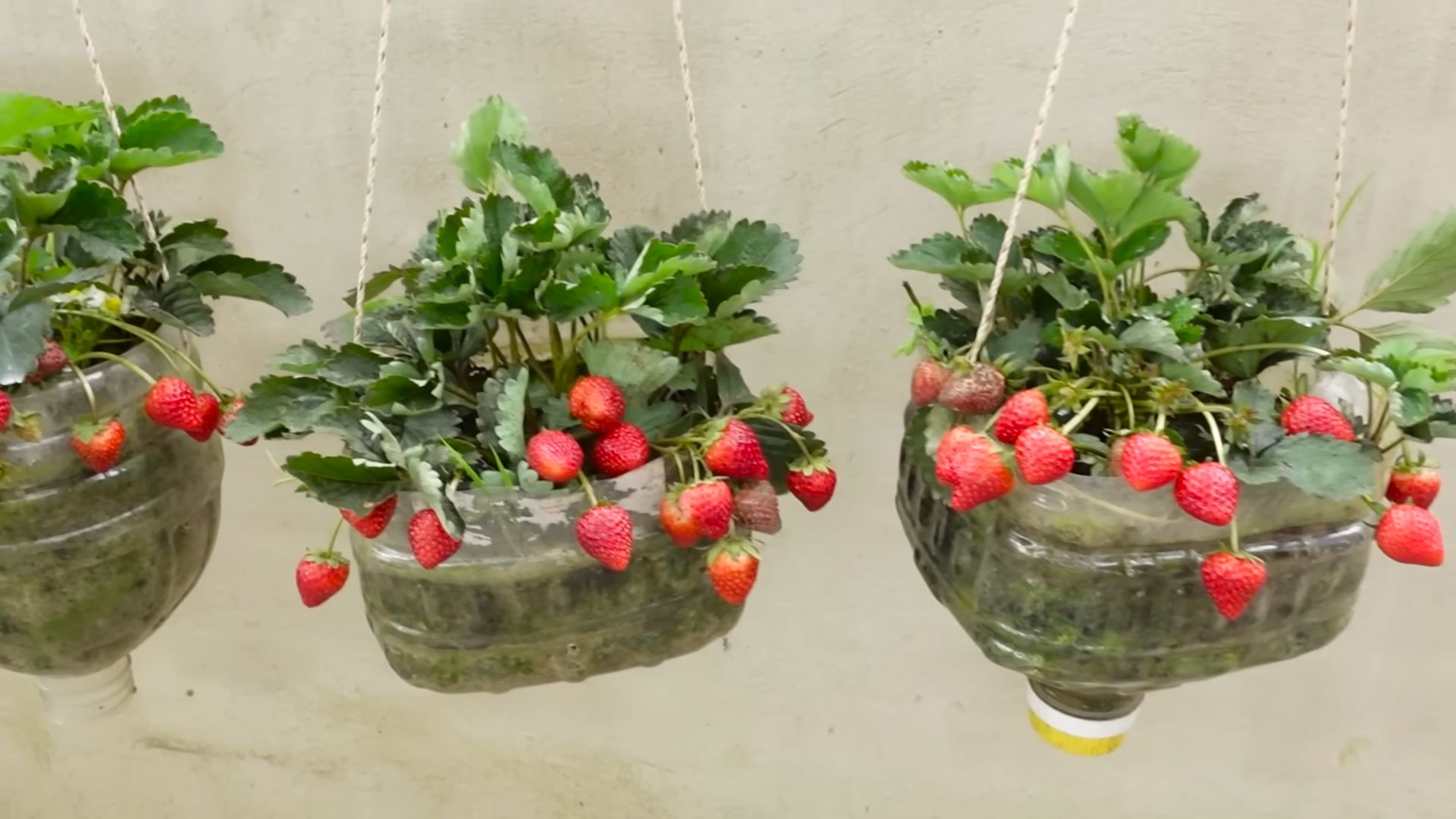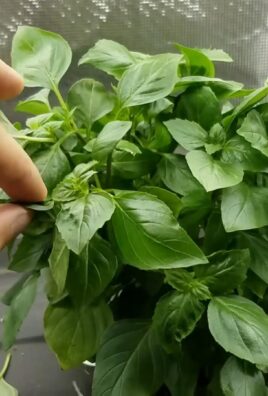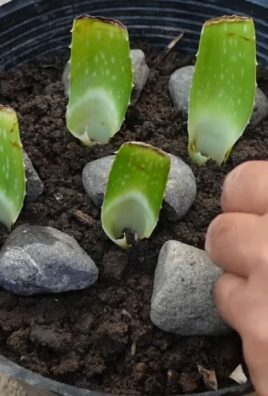Growing Strawberries Without a Garden? Absolutely! Imagine plucking juicy, sun-ripened strawberries right from your balcony or windowsill, even if you don’t have a sprawling backyard. Sounds like a dream, right? Well, it’s a dream that can easily become a reality with a few clever DIY tricks. For centuries, people have cultivated strawberries, from the wild berries enjoyed by ancient Romans to the carefully bred varieties we savor today. But what if you live in an apartment or have limited outdoor space? That’s where these ingenious hacks come in!
I’m here to tell you that you don’t need acres of land to enjoy the sweet taste of homegrown strawberries. In fact, growing strawberries without a garden is easier than you might think. This article is packed with simple, affordable, and space-saving DIY projects that will transform your small space into a strawberry paradise. We’ll explore vertical gardening, container planting, and even repurposing everyday items to create the perfect environment for your strawberry plants to thrive.
Why do you need these DIY tricks? Because everyone deserves the joy of fresh, organic strawberries, regardless of their living situation. Plus, store-bought strawberries often lack the intense flavor of homegrown ones. So, let’s ditch the store-bought berries and embark on a fun and rewarding journey of growing your own delicious strawberries, no garden required!

Growing Strawberries Without a Garden: A DIY Guide to Container Gardening Success
Hey there, fellow plant enthusiasts! Dreaming of juicy, red strawberries but lacking a traditional garden? Don’t worry, I’ve got you covered! Growing strawberries in containers is surprisingly easy and rewarding. I’ve been doing it for years, and I’m excited to share my secrets with you. This guide will walk you through everything you need to know to enjoy a bountiful strawberry harvest, even if you only have a balcony, patio, or sunny windowsill.
Choosing the Right Container and Variety
First things first, let’s talk about containers and strawberry varieties. This is crucial for setting yourself up for success.
* Container Size: Strawberries need room to spread their roots. I recommend using containers that are at least 12 inches in diameter and 8 inches deep. You can use individual pots for each plant or opt for larger containers like hanging baskets, window boxes, or even repurposed items like old buckets or tubs. Just make sure they have drainage holes!
* Container Material: Plastic, terracotta, and ceramic pots all work well. Plastic pots tend to retain moisture better, which can be beneficial in hotter climates. Terracotta pots are more breathable, which can help prevent root rot in wetter climates.
* Strawberry Varieties: This is where things get interesting! There are three main types of strawberries:
* June-Bearing: These varieties produce one large crop of strawberries in the spring, usually around June (hence the name!). They’re great if you want a big harvest all at once for making jam or freezing. Some popular June-bearing varieties include ‘Chandler,’ ‘Honeoye,’ and ‘Earliglow.’
* Everbearing: Everbearing strawberries produce two to three smaller crops throughout the growing season – spring, summer, and fall. They’re a good choice if you want a continuous supply of strawberries. ‘Seascape,’ ‘Ozark Beauty,’ and ‘Albion’ are some excellent everbearing options.
* Day-Neutral: Day-neutral strawberries are similar to everbearing varieties, producing fruit throughout the growing season. However, they are less sensitive to day length, meaning they’ll produce fruit regardless of how long the days are. ‘Tristar’ and ‘Tribute’ are popular day-neutral choices.
I personally prefer everbearing or day-neutral varieties for container gardening because I love having fresh strawberries available for a longer period.
Preparing Your Container and Soil
Now that you’ve chosen your container and strawberry variety, it’s time to get your hands dirty!
* Drainage: Make sure your container has adequate drainage holes. If not, drill a few extra ones. Strawberries don’t like sitting in soggy soil.
* Soil: Use a high-quality potting mix that’s well-draining and rich in organic matter. Avoid using garden soil, as it can become compacted in containers and doesn’t drain well. I like to mix equal parts potting mix, compost, and perlite or vermiculite for added drainage.
* Filling the Container: Fill your container with the potting mix, leaving about an inch or two of space at the top. This will make watering easier.
Planting Your Strawberry Plants
Okay, the fun part! Let’s get those strawberry plants in their new home.
1. Gently Remove the Plants: Carefully remove the strawberry plants from their nursery containers. Gently loosen the roots with your fingers.
2. Dig a Hole: Dig a hole in the potting mix that’s large enough to accommodate the root ball of the strawberry plant.
3. Planting Depth: This is important! Plant the strawberry plant so that the crown (the point where the roots meet the stem) is level with the soil surface. Planting it too deep can cause the crown to rot, while planting it too shallow can dry out the roots.
4. Spacing: If you’re planting multiple strawberry plants in the same container, space them about 8-12 inches apart to allow for adequate growth.
5. Water Thoroughly: After planting, water the strawberry plants thoroughly until water drains out of the bottom of the container. This will help settle the soil and encourage root growth.
Caring for Your Container Strawberries
Now that your strawberry plants are planted, it’s time to provide them with the care they need to thrive.
* Sunlight: Strawberries need at least 6-8 hours of sunlight per day to produce fruit. Place your containers in a sunny location. If you don’t have a sunny spot, you can supplement with grow lights.
* Watering: Water your strawberry plants regularly, especially during hot, dry weather. The soil should be consistently moist but not soggy. Check the soil moisture by sticking your finger into the soil. If the top inch feels dry, it’s time to water. I usually water deeply every few days, allowing the water to drain out of the bottom of the container.
* Fertilizing: Strawberries are heavy feeders, so they need regular fertilization. Use a balanced fertilizer (e.g., 10-10-10) every 2-3 weeks during the growing season. You can also use a liquid fertilizer diluted according to the package instructions. I like to use a fertilizer specifically formulated for berries.
* Mulching: Mulching around your strawberry plants helps retain moisture, suppress weeds, and keep the berries clean. You can use straw, wood chips, or even black plastic mulch.
* Pest and Disease Control: Keep an eye out for pests and diseases. Common strawberry pests include aphids, spider mites, and slugs. You can control these pests with insecticidal soap, neem oil, or by handpicking them off the plants. Common strawberry diseases include powdery mildew and gray mold. You can prevent these diseases by providing good air circulation and avoiding overhead watering. If you notice any signs of disease, remove the affected leaves or fruit.
* Pruning: Remove any dead or yellowing leaves to keep your strawberry plants healthy. You can also prune runners (the long stems that strawberry plants send out) to encourage the plants to focus their energy on producing fruit. However, if you want to propagate new strawberry plants, you can allow the runners to root in small pots filled with potting mix.
* Winter Protection: In colder climates, you’ll need to protect your strawberry plants from frost and freezing temperatures. You can move the containers to a sheltered location, such as a garage or shed, or you can cover them with a layer of straw or burlap.
Harvesting Your Strawberries
The moment you’ve been waiting for! Harvesting your delicious, homegrown strawberries.
* Ripeness: Strawberries are ready to harvest when they are fully red and slightly soft to the touch.
* Harvesting Technique: Gently twist or cut the strawberry from the plant, leaving a small piece of the stem attached.
* Timing: Harvest your strawberries in the morning, after the dew has dried. This will help prevent them from becoming mushy.
* Storage: Store your strawberries in the refrigerator for up to a week. Don’t wash them until you’re ready to eat them, as washing them can cause them to spoil more quickly.
Troubleshooting
Even with the best care, you might encounter some challenges along the way. Here are a few common problems and how to fix them:
* No Fruit: If your strawberry plants aren’t producing fruit, it could be due to a lack of sunlight, insufficient watering, or inadequate fertilization. Make sure your plants are getting enough sunlight, water them regularly, and fertilize them every 2-3 weeks.
* Small Fruit: Small fruit can be caused by overcrowding, insufficient watering, or a lack of nutrients. Thin out your plants if they’re overcrowded, water them regularly, and fertilize them with a balanced fertilizer.
* Yellowing Leaves: Yellowing leaves can be a sign of nutrient deficiency, overwatering, or disease. Check the soil moisture and adjust your watering accordingly. Fertilize your plants with a balanced fertilizer. If you suspect disease, remove the affected leaves and treat the plants with a fungicide.
* Pests: As mentioned earlier, common strawberry pests include aphids, spider mites, and slugs. Control these pests with insecticidal soap, neem oil, or by handpicking them off the plants.
Extra Tips for Strawberry Success
Here are a few extra tips I’ve learned over the years that can help you maximize your strawberry harvest:
* Rotate Your Plants: If you’re growing strawberries in the same containers year after year, it’s a good idea to rotate your plants to prevent soilborne diseases.
* Use Companion Plants: Planting certain companion plants alongside your strawberries can help deter pests and attract beneficial insects. Some good companion plants for strawberries include basil, thyme, and marigolds.
* Protect from Birds: Birds love strawberries just as much as we do! Protect your plants with netting or bird repellent.
* Enjoy the Process: Growing strawberries is a rewarding experience. Don’t be afraid to experiment and have fun!
Growing strawberries

Conclusion
So, there you have it! Growing strawberries without a garden isn’t just a whimsical dream; it’s an achievable reality thanks to this simple, effective DIY trick. We’ve walked you through the process, highlighting the ease and accessibility of creating your own strawberry haven, even if you’re short on space. But why is this method a must-try?
Firstly, it democratizes gardening. No longer is fresh, homegrown produce the exclusive domain of those with sprawling backyards. Apartment dwellers, balcony enthusiasts, and anyone with limited outdoor space can now savor the unparalleled taste of freshly picked strawberries. Imagine the joy of plucking ripe, juicy berries right outside your kitchen window, knowing you nurtured them from tiny seedlings.
Secondly, it’s incredibly cost-effective. Compared to purchasing strawberries from the grocery store, which can be expensive and often lack the intense flavor of homegrown varieties, this DIY approach allows you to cultivate a continuous supply of delicious fruit at a fraction of the cost. Think of all the strawberry shortcakes, smoothies, and healthy snacks you can create without breaking the bank!
Thirdly, it’s a sustainable and environmentally friendly option. By growing your own strawberries, you’re reducing your reliance on commercially grown produce, which often involves long-distance transportation and the use of pesticides. You’re actively contributing to a healthier planet by embracing a more localized and eco-conscious approach to food production.
But the beauty of this DIY strawberry growing method lies not only in its practicality but also in its adaptability. Feel free to experiment with different container types. While we’ve focused on using readily available materials like buckets or plastic containers, you could also explore hanging baskets, vertical planters, or even repurposed items like old tires or wooden pallets. The possibilities are endless!
Consider also experimenting with different strawberry varieties. Some varieties are better suited for container gardening than others. Everbearing strawberries, for example, produce fruit throughout the growing season, providing a continuous harvest. Day-neutral strawberries are also a good choice, as they are less sensitive to day length and can produce fruit even in partial shade. Research different varieties and choose the ones that best suit your climate and growing conditions.
Furthermore, don’t be afraid to get creative with your growing medium. While a standard potting mix works well, you can also incorporate compost, perlite, or vermiculite to improve drainage and aeration. Adding a slow-release fertilizer can also provide your strawberry plants with the nutrients they need to thrive.
This DIY trick for growing strawberries without a garden is more than just a gardening project; it’s an opportunity to connect with nature, cultivate your own food, and experience the satisfaction of nurturing something from seed to fruit. It’s a chance to add a touch of green to your urban landscape and enjoy the sweet rewards of your labor.
So, what are you waiting for? Gather your supplies, follow our simple instructions, and embark on your own strawberry-growing adventure. We’re confident that you’ll be amazed at how easy and rewarding it is to grow your own delicious strawberries, even without a traditional garden.
We encourage you to try this DIY trick and share your experiences with us! Post photos of your strawberry plants, share your tips and tricks, and let us know how this method has transformed your gardening experience. We’re eager to hear your success stories and learn from your insights. Together, we can create a community of urban gardeners who are passionate about growing their own food and sharing the joy of fresh, homegrown strawberries. Happy growing!
Frequently Asked Questions (FAQ)
What kind of container is best for growing strawberries without a garden?
The best container for growing strawberries without a garden depends on your space and aesthetic preferences. Buckets, plastic containers, hanging baskets, and vertical planters are all viable options. Ensure the container has drainage holes to prevent waterlogging. The size should be at least 12 inches in diameter and 8 inches deep to accommodate the roots. Terracotta pots are also a good choice as they allow the soil to breathe, but they can dry out faster than plastic containers. Ultimately, the most important factor is that the container provides adequate space and drainage for your strawberry plants to thrive.
How much sunlight do strawberries need when grown in containers?
Strawberries thrive in full sun, requiring at least 6-8 hours of direct sunlight per day. If you’re growing strawberries on a balcony or patio, position the containers in a location that receives ample sunlight throughout the day. If you live in a particularly hot climate, providing some afternoon shade can help prevent the plants from overheating. If you don’t have access to enough natural sunlight, you can supplement with grow lights.
What type of soil is best for growing strawberries in containers?
A well-draining potting mix is essential for growing strawberries in containers. Avoid using garden soil, as it can become compacted and hinder drainage. A mixture of peat moss, perlite, and vermiculite provides excellent drainage and aeration. You can also add compost to enrich the soil with nutrients. A slightly acidic soil pH of 5.5 to 6.5 is ideal for strawberries.
How often should I water my strawberry plants in containers?
Water your strawberry plants regularly, especially during hot and dry weather. The soil should be consistently moist but not waterlogged. Check the soil moisture by inserting your finger about an inch deep. If the soil feels dry, it’s time to water. Water deeply, allowing the water to drain out of the drainage holes. Avoid overhead watering, as it can promote fungal diseases. Drip irrigation or soaker hoses are excellent options for providing consistent moisture to the roots.
What kind of fertilizer should I use for my container-grown strawberries?
Strawberries are heavy feeders and benefit from regular fertilization. Use a balanced fertilizer with an NPK ratio of 10-10-10 or 14-14-14. Apply the fertilizer according to the package instructions, typically every 2-4 weeks during the growing season. You can also use a slow-release fertilizer at the beginning of the season to provide a continuous supply of nutrients. Organic fertilizers, such as compost tea or fish emulsion, are also excellent options.
How do I protect my strawberry plants from pests and diseases?
Regularly inspect your strawberry plants for signs of pests and diseases. Common pests include aphids, spider mites, and slugs. You can control aphids and spider mites with insecticidal soap or neem oil. Slugs can be controlled with slug bait or by handpicking them off the plants. Common diseases include powdery mildew and gray mold. Prevent these diseases by providing good air circulation, avoiding overhead watering, and removing any infected leaves.
How do I overwinter my strawberry plants in containers?
In colder climates, strawberry plants in containers need protection during the winter. You can move the containers to a sheltered location, such as a garage or shed, or insulate them with straw or burlap. Water the plants sparingly during the winter, only enough to keep the soil from completely drying out. In milder climates, you may be able to leave the containers outdoors, but be sure to protect them from frost.
When will my strawberry plants start producing fruit?
The time it takes for strawberry plants to produce fruit depends on the variety and growing conditions. Everbearing strawberries typically produce fruit throughout the growing season, while June-bearing strawberries produce a large crop in the spring. Generally, you can expect to harvest your first strawberries within a few months of planting. Be patient and provide your plants with the care they need, and you’ll be rewarded with delicious, homegrown strawberries.
Can I grow strawberries indoors using this DIY method?
Yes, you can grow strawberries indoors using this DIY method, but you’ll need to provide them with adequate light. Place the containers near a sunny window that receives at least 6-8 hours of direct sunlight per day. If you don’t have access to enough natural sunlight, you can supplement with grow lights. Ensure the plants have good air circulation and are watered regularly. Indoor growing can extend the strawberry season and allow you to enjoy fresh strawberries year-round.
How do I know when my strawberries are ripe and ready to pick?
Strawberries are ripe when they are fully red and slightly soft to the touch. The berries should also detach easily from the plant. Avoid picking strawberries that are still green or white, as they will not ripen further after being picked. Pick your strawberries in the morning, after the dew has dried. Enjoy your freshly picked strawberries immediately or store them in the refrigerator for a few days.





Leave a Comment